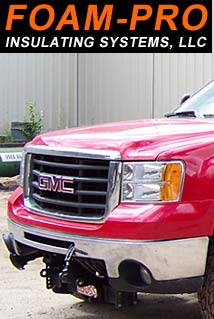| |
|
Closed-Cell Versus Open-Cell Polyurethane Spray Foam
Polyurethane spray foam is often categorized as either "open-cell" or "closed-cell". There are several major differences between the two types, leading to advantages and disadvantages for both, depending on the desired application requirements. In addition, polyurethane spray foam is an extremely versatile material that is available in a variety of final physical properties and densities, so it is necessary for the end-user to have an understanding of these differences, and to choose the spray foam system that is best suited for the particular application requirements.
The purpose of this article is to provide a summary of the advantages and disadvantages of open-cell and closed-cell polyurethane spray foam;
Closed-Cell polyurethane spray foam is among the most efficient insulating
material commercially available, with R-Values commonly around 6.0 per inch.
Closed-cell foam incorporates an insulating gas that is retained within the cells
(foam "blowing agent"), which leads to the highly efficient insulating properties
of the material. In the U.S., insulation is measured in "R-Value" (R=resistance
to heat flow), and closed-cell polyurethane spray foam has among the highest
R-Values of any commercially available insulation. In addition, the closed-cell
nature of this foam provides for a highly effective air barrier, low moisture
vapor permeability (often referred to as the "Perm" rating), and excellent resistance
to water. The most common foam density for closed-cell polyurethane foam is approximately
2.0 pounds per cubic feet. Years of research and commercial experience has shown
that the 1.75 - 2.25 lb/ft3 density range provides the optimum insulating and
strength characteristics for most building applications. Closed-cell polyurethane
foam are usually characterized by their rigidity and strength, in addition to
the high R-Value. Also studies show that wall racking strength can be doubled
or tripled when closed cell foam is applied.
Open-Cell polyurethane spray foam on the other hand, is usually found
in densities ranging from 0.4 to 1.2 lbs/ft3. One of the advantages that these
lower densities provide is a more economical yield, since foam density is directly
related to yield (lower density=higher yeld). Although the R-Value of open-cell
foams is slightly more than half that of closed-cell foams, usually around 3.5
per inch, these products can still provide excellent thermal insulating and air
barrier properties. Open-cell foam is more permeable to moisture vapor, with
perm ratings of approximetly 10.0 per 4-5 inches thickness (up to 50 perms at
one inch). Howeverr, the foam allows for a very controlled diffusion of moisture
vapor whose consistency can be managed by the builder/architect. Open-cell foam
are incredibly effective as a sound barrier, having about twice the sound resistance
in normal frequency ranges as closed-cell foam. Other characteristics of open-cell
polyurethane foam usually includes a softer, "spongier" appearance, as well as
lower strength and rigidity than closed-cell foams.
Application that typically use open-cell foam include residential construction
insulation, under roof trusses for "conditioned attics", and for sound deadening
in media rooms, etc. Closed-cell foam, while also useful in residential construction
isulation, is used in a variety of commercial, industrial and rsidential applications
because of the excellent strength and insulating properties described here.
In a "bullet point" list, the comparison of closed-cell open-cell polyurethane foams is as follows;
| CLOSED-CELL | OPEN-CELL |
Highest insulating "R-Value"
7.0 per inch |
Good insulation value (R=3.81) per inch |
| Low vapor permeability (low perm) |
Higher vapor permeability, but controlled |
| Air barrier | Economical yield |
| Increases wall strength | Air barrier |
Resists water
(is a WRB - "Water Resistive Barrier") | Best sound absorption in normal noise frequency ranges |
| Absorbs sound, especially bass tones | Low density (0.41.2 lbs/ft3 |
| Medium density (1.75-2.25 lbs/ft3 | |
|
|






